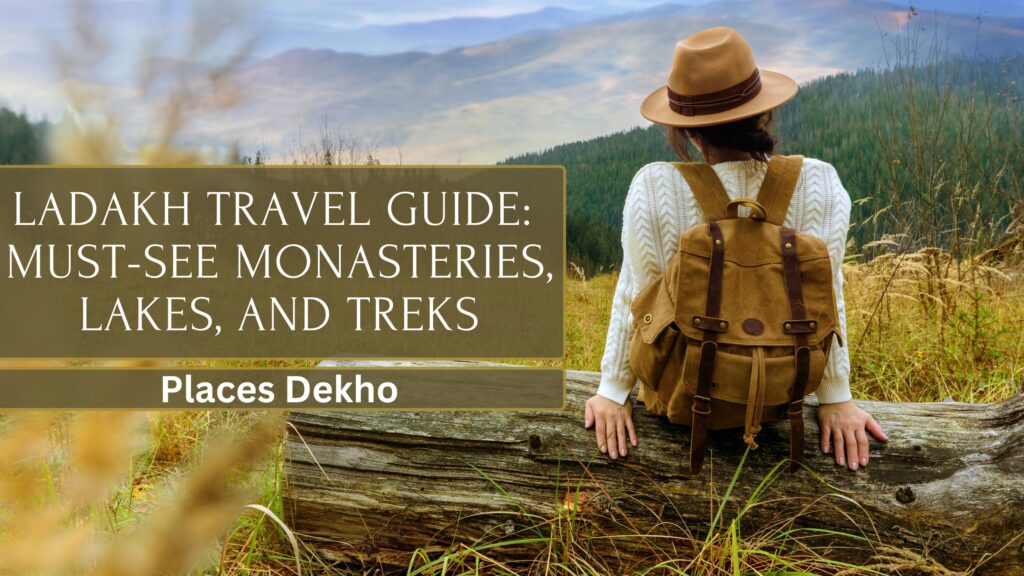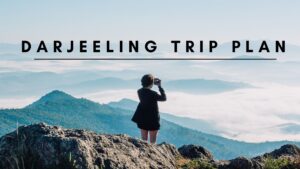Ladakh is the most stunning destination we’ve ever encountered. Nestled in the remote northern reaches of the Indian Himalayas, this rugged region is encircled by the snow-covered peaks of the Zanskar, Ladakh, and Karakoram mountain ranges. Ancient monasteries perch on windswept hilltops, while lush green fields and small villages stretch across the valleys below.
This high-altitude region, sitting above 3,500 meters, offers true adventure. From pristine alpine lakes to treks connecting secluded villages, Ladakh is filled with unforgettable, almost surreal experiences waiting to be discovered.
We’ve had the chance to explore Ladakh twice, each time spending close to six weeks based in Leh. Drawing from those visits, We’ve created this detailed travel guide to Ladakh, covering everything you need to know for your journey to Leh and beyond.
Overview of Ladakh
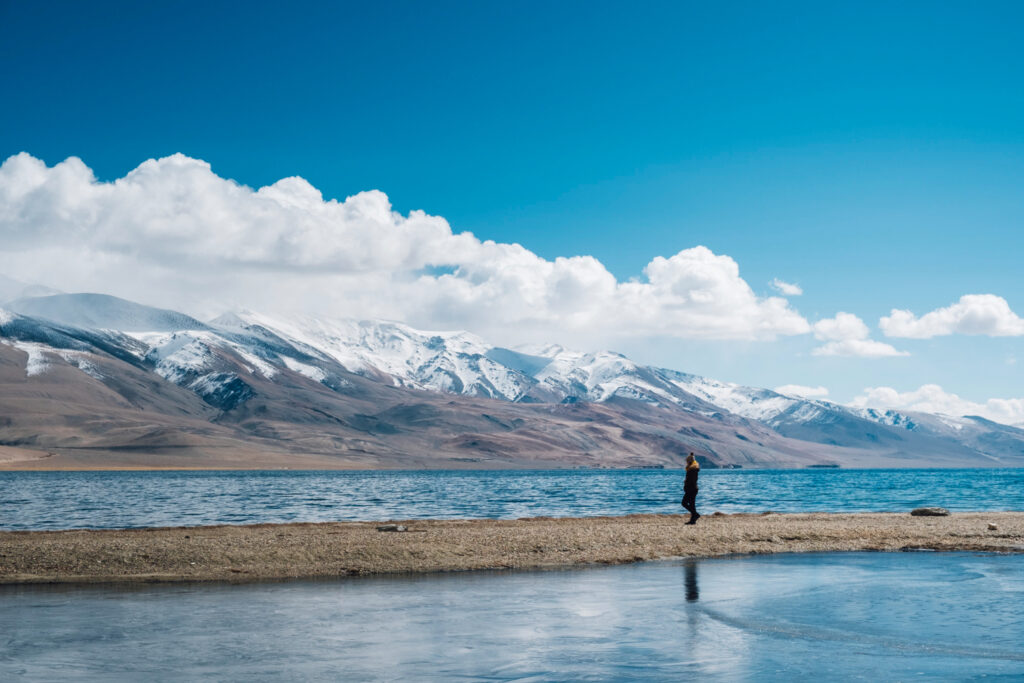
Ladakh lies in the far northern reaches of the Indian subcontinent, bordered by Pakistan to the west and China and Tibet to the north and east. The greater Ladakh region also extends into what is now Gilgit-Baltistan in Pakistan. Both Ladakh and Gilgit-Baltistan share deep cultural, historical, and ethnic ties.
Once part of the ancient Tibetan Kingdom, Ladakh is still home to a primarily Buddhist population. As a result, the region’s culture, language, cuisine, ambiance, and architecture stand in sharp contrast to much of the rest of India.
Previously part of the state of Jammu and Kashmir, Ladakh became a separate Union Territory in 2019.
Leh, the region’s capital and main transportation center, serves as the ideal base for exploring Ladakh. While some use the terms interchangeably, it’s important to note that Leh is a town, whereas Ladakh refers to the entire region.
Best Time to Visit Ladakh
The peak travel season in Ladakh is from June to August. During these months, the weather is at its best—days are pleasantly warm, and nights are relatively mild. Most importantly, the roads are generally free of snow, making travel around the region much more accessible.
If you’re planning to join group tours or treks starting from Leh, this is the ideal time. You’ll find more fellow travelers and greater availability of organized departures. Outside of the summer season, it can be challenging to find regular group tours.
The roads connecting Leh to Manali and Srinagar typically remain open from April or May until around September or October, depending on the weather. The Leh–Manali highway, due to its higher altitude, usually opens later and closes earlier than the Srinagar route.
For trekking, the best time to visit is from August to mid-September. During this period, the weather remains stable, and the trails are generally free from snow and ice, making high-altitude passes and routes safer to navigate.
How to Reach Leh, Ladakh
This is where the real adventure begins. Leh, the capital of Ladakh, can be reached either by air or by road. Air travel is the only year-round option, while road access is generally possible from May to October. You’ll find public and shared transport options available from both Kashmir and Himachal Pradesh during the travel season.
By Air
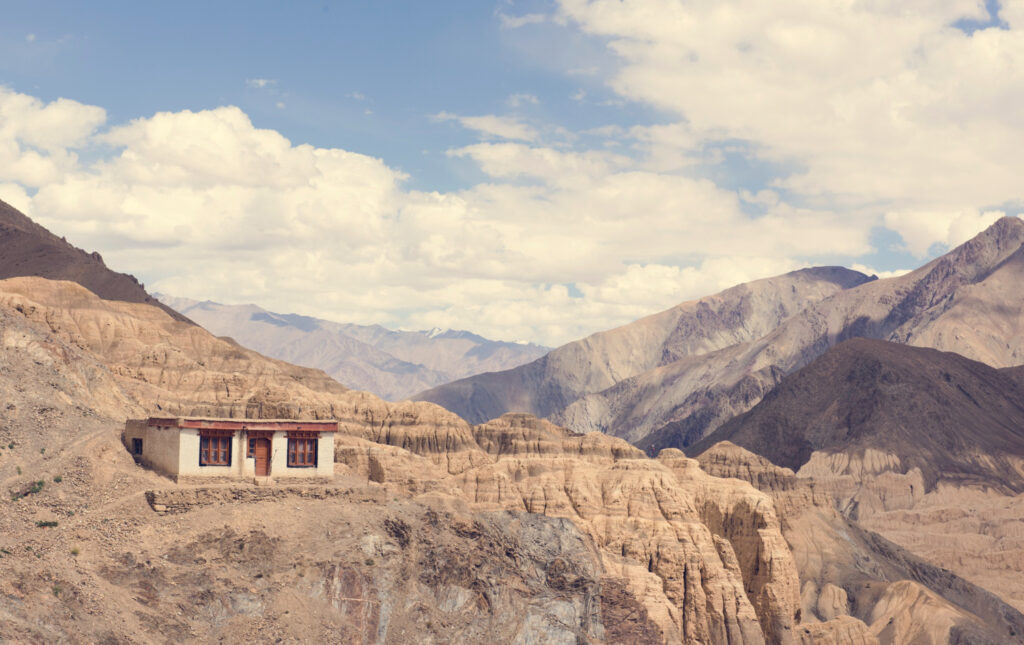
If you’re short on time or not keen on spending days on rough mountain roads, flying is the best option. Regular flights operate year-round between Delhi and Leh. In winter, this is the only reliable way to reach Ladakh.
Airlines such as Air India, Vistara, SpiceJet, and IndiGo operate flights on this route. The flight takes about 1.5 hours and typically costs between ₹3000 (AU$60) and ₹9000 (AU$180) one way, depending on the season and demand.
By Road

Traveling to Leh by road is considered one of the most scenic road journeys in the world. It’s an exhilarating ride—though not for the faint-hearted—with narrow, winding roads and steep drop-offs. However, road conditions have improved in recent years, with many sections now fully paved.
You can approach Leh from two main directions:
- From Srinagar (Kashmir) to the west
- From Manali (Himachal Pradesh) to the southeast
During summer, both routes are served by public buses, government-operated tourism buses, and shared taxis.
For most travelers, the Manali route is more popular, though it’s the tougher of the two. The Srinagar–Leh route is less traveled but offers a more gradual ascent, making it a better option for those concerned about altitude sickness or planning to explore Kashmir.
The highest point on the Srinagar–Leh road is Fotu La at 4,100 meters, with a more gradual climb to Leh’s 3,500 meters. In contrast, the Manali–Leh route averages 4,000 meters in elevation and crosses three high passes over 5,000 meters, including the towering Tanglang La at 5,320 meters.

Is it Safe to Visit Ladakh?
While the region’s political situation can sometimes seem complex, Leh town has remained calm and peaceful for many years. Occasional tensions do arise near the borders with Pakistan and Tibet, but these are typically far from Leh and do not impact most travelers.
Ladakh feels very safe overall. The strong military presence throughout the region ensures that any border-related issues are contained and rarely affect tourist areas.
Ladakh also has one of the lowest crime rates in India. Locals are incredibly kind and welcoming, making it one of the most relaxing and friendly regions to explore in the country.
Where to Stay in Leh

Leh offers a wide variety of accommodations, ranging from backpacker hostels to luxury hotels. A great option is staying in a family-run guesthouse. These provide a more personal experience and a deeper connection to Ladakhi culture. Having stayed in several places across different budgets, I can recommend options for various price ranges.
Where to Eat in Leh

Food is one of the highlights in Leh. The town is filled with excellent cafes and restaurants serving traditional Ladakhi and Tibetan dishes, along with international options like Thai and Italian. Some of my top picks are:
- Bodhi Terrace
- Tibetan Kitchen
- Chopsticks
- Wanderers Terrace
- Asian Corner
How to Get Around Ladakh
Getting around Ladakh from Leh is quite manageable. You can hire your own vehicle, take public transport, or join group tours. For budget travelers, a mix of public transport and organized tours can be the most efficient and economical option. Taxis are also useful, especially when visiting less accessible places.
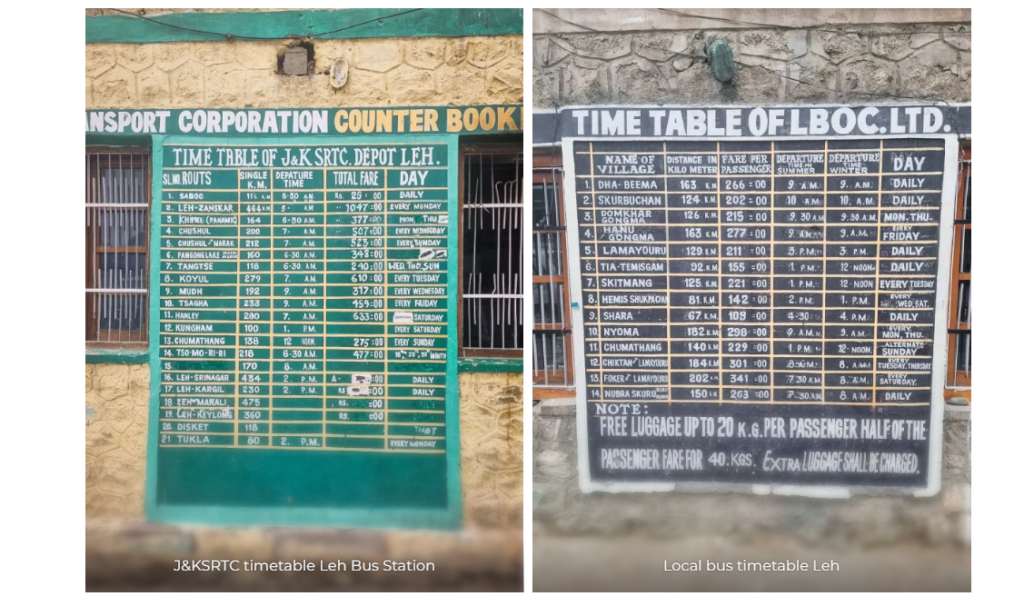
Public Transport in Ladakh
Public transportation in Leh is limited and can be slow, but it’s affordable and offers a local experience.
To visit places east of Leh—like Shey Palace, Thiksey Monastery, and Stakna Monastery—you can catch a local bus from Leh’s main gate to Choglamsar. From there, transfer to another bus running along the main highway that passes Shey and Thiksey. Tickets are very cheap (under ₹50), and buses run throughout the day, though only when full. Returning to Leh may require waiting along the highway or hitchhiking.
For longer trips, there are occasional public buses to:
- Diskit (Nubra Valley)
- Pangong Lake
- Tso Moriri
Schedules vary, so check with the Leh main bus station for the latest information.
There are also daily buses to Lamayuru, and a few buses per week to Likir (for the Sham Valley trek) and Chilling (for the Markha Valley trek). Again, schedules should be confirmed in person at the station.
Shared Taxis and Group Tours
The easiest and most practical way to reach Ladakh’s top attractions is by joining a group tour. While this might not be your usual travel style, it’s a smart and budget-friendly choice in Ladakh.
Travel agencies in Leh offer organized group tours to places like Pangong Lake, Nubra Valley, and Turtuk. These usually run for either four days and three nights or three days and two nights without Turtuk.
Prices begin at around ₹24,000 (approximately AU$450) for a private vehicle and driver for a three-day trip covering Pangong and Nubra. If you include Turtuk, the cost increases. Sharing this cost among 6–7 people significantly reduces the expense per person.
Accommodation isn’t included, so you’ll need to book your own stays. You can arrange this in advance online or wait until you arrive, as many drivers have preferred guesthouses to recommend in Pangong, Diskit, or Hunder.
Prices for tours are generally consistent across all agencies due to union-set rates. Simply walk through Leh and check the tour departure notices on agency doors to join a group on your preferred date.
Private Taxis

For day trips close to Leh, hiring a taxi is a convenient and affordable option. All taxis follow union-set prices, which they carry in an official booklet—so prices are fixed and non-negotiable.
Popular routes include a day trip combining Shey, Thiksey, and Hemis monasteries, which costs around ₹3,700 (AU$70).
Taxis are also useful for trekking drop-offs, such as to Likir for ₹2,000 (AU$40) or Chilling for ₹3,600 (AU$70).
Motorbike Rentals

Exploring Ladakh by motorbike is especially popular among Indian tourists. You’ll find many rental shops in Leh offering Royal Enfield bikes at daily rates that start affordably.
However, due to the challenging road conditions, bike rental is only advisable for experienced and licensed riders.
For those less confident on a motorcycle, scooter rentals have become more common in Leh and are a great alternative for getting around locally.
How Long Should You Stay in Ladakh?
It’s hard for me to be objective—We’ve spent a total of 12 weeks in Ladakh over two trips! But practically speaking, a 10-day visit is ideal for seeing more than just Leh.
If you’d like to include a short trek, like the Sham Valley or Markha Valley, aim for two weeks. You can extend your stay even further if you want to explore remote regions like Zanskar or Tso Moriri.
Permits for Visiting Ladakh
Though no permit is needed to enter Leh itself, visiting certain areas classified as sensitive requires official authorization.
- Indian citizens need an Inner Line Permit (ILP)
- Foreign nationals require a Protected Area Permit (PAP)
Places requiring a permit include:
- Pangong Lake
- Nubra Valley
- Turtuk
- Tso Moriri
- Dha-Hanu Valley
Permits can be arranged either through a travel agency (if booking a tour) or personally at the Deputy Commissioner’s Office in Leh. Processing usually takes a few hours, depending on demand.
Fees include:
- ₹400 for environment charges
- ₹100 Red Cross donation
- ₹20/day for wildlife protection
Total for a three-day trip: ₹560 (AU$11)
Destinations like Thiksey, Hemis, and Lamayuru do not require a permit, but always carry your passport for identification.
Top Places to Visit in Ladakh
Leh Market
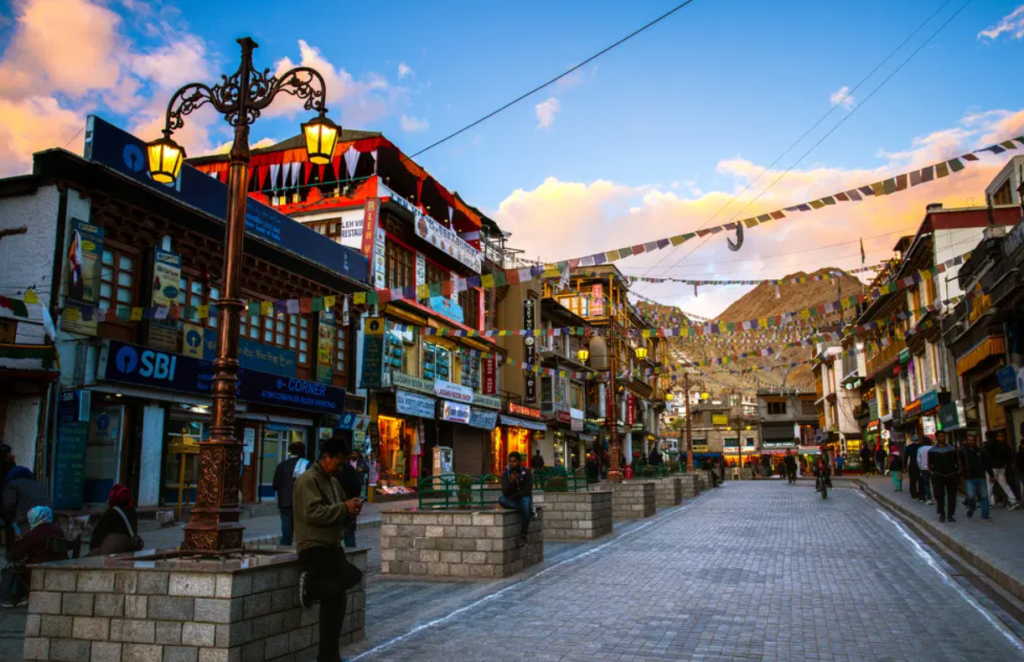
Leh’s central hub is its bustling market area. Leh Bazaar Road, the pedestrian-friendly main street, is lined with shops selling souvenirs, books, trekking gear, and essentials. You’ll also find cafes, banks, and tour operators.
At the northern end is Jama Masjid, while the Leh Buddhist Temple is on the western side. With Leh Palace looming above and colorful prayer flags fluttering in the breeze, this is the beating heart of the town.
Shanti Stupa

Shanti Stupa, the iconic white peace pagoda perched on a hill, offers unmatched views of Leh and its surroundings. Built in 1991 with Japanese support, it’s a serene spot, especially at sunset when golden light spills across the mountains.
You can reach it either by taxi or by walking up the 500 steps from Changspa Road. A round-trip taxi ride with wait time typically costs ₹400 (AU$8).
Overlooking the town, Leh Palace is one of the most prominent landmarks. Constructed in the 17th century by the Namgyal royal family, it was abandoned after the Dogra invasion in the mid-1800s.
Leh Palace

Now open as a museum, the nine-story structure offers fantastic panoramic views from the top floor. Although much of the palace is empty, restored rooms and exhibits make it a fascinating visit.
You can either drive up or take a scenic walk from the old town via a set of stone stairs.
Entry fee: ₹100 (AU$2)
Tsemo Maitreya Temple
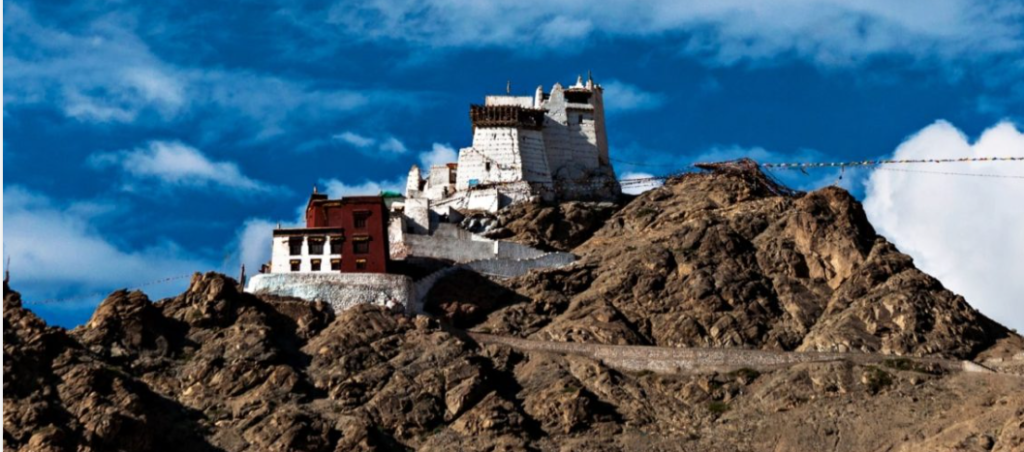
Perched above Leh Palace, Tsemo Maitreya Temple is one of the best sunset viewpoints in Leh. This scenic temple and ruined fort complex offer panoramic views of the valley as golden light bathes the mountains.
You can reach the temple either by driving or hiking up. Two main trails lead to the top:
- From Chubi: A paved trail with stairs starting beside the Chubi HP Petrol Station on Sankar Road.
- From Leh Palace: A steeper dirt trail cut into the mountainside.
Entry Fee: ₹30 (AU$0.60)
Khardung La Pass
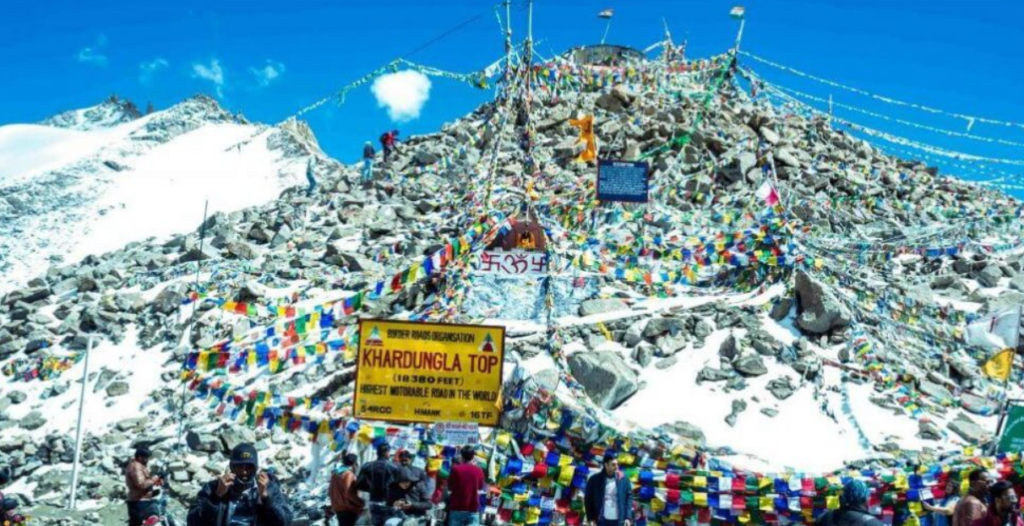
Known as one of the world’s highest motorable roads, Khardung La stands at an altitude of 5,360m. Once the highest road globally, it now ranks second, but remains the most famous in Ladakh.
It connects Leh with Nubra Valley and is often part of the route to Diskit, Hunder, and Pangong Lake. While some travelers do a day trip up to the pass, the real adventure lies in continuing toward Nubra.
- Road Conditions: Generally good but susceptible to landslides and snow.
- Open Season: June to September (check road status beforehand).
Nubra Valley

A must-visit from Leh, Nubra Valley lies across Khardung La and follows the Shyok River through dramatic Himalayan landscapes. Once part of the Silk Road, it now welcomes travelers to its remote beauty.
- Diskit Monastery: Famous for its 100-ft Maitreya Buddha and ancient cliffside monastery.
- Hunder: Known for its desert-like sand dunes and Bactrian (double-humped) camels.
Entry Fee (Diskit Monastery): ₹40 (AU$0.80)
Pangong Lake

Located at 4,250m, Pangong Tso is a stunning saltwater lake stretching from Ladakh into Tibet. Its deep blue hue against stark, arid mountains creates one of India’s most iconic vistas.
- Access: Via Changla Pass (5,360m) from Leh.
- Popular Stay: Spangmik village with glamping tents and lodges.
- Alternative Stays: Man and Merak villages for quieter experiences.
Most travelers include Pangong in a loop with Nubra Valley, spending at least one night by the lake.
Turtuk
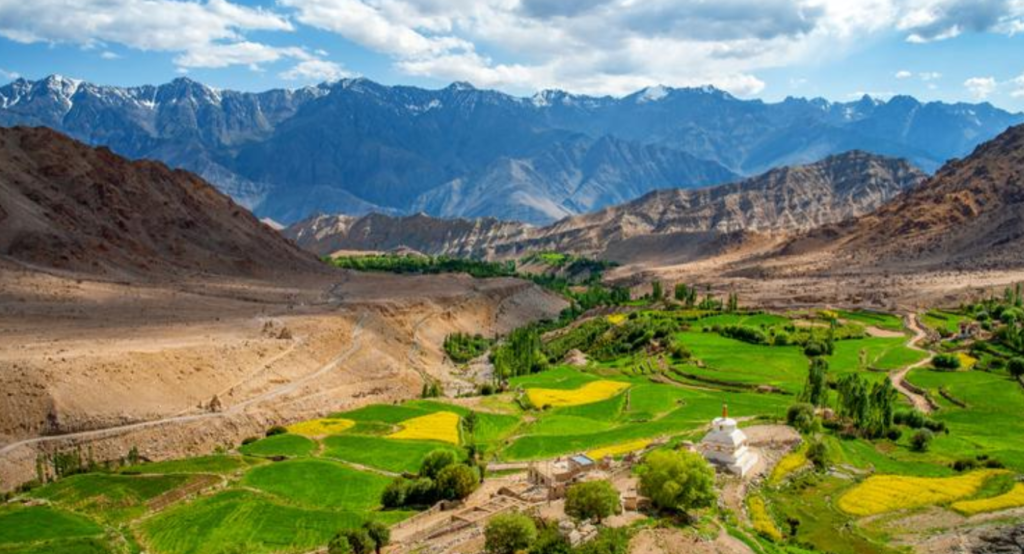
India’s northernmost village open to tourists, Turtuk is home to the Balti people, culturally distinct and originally from the Baltistan region in present-day Pakistan.
- Experience: Traditional homes, friendly locals, and a serene environment.
- Accommodation: Numerous homestays offering rooms and meals for around ₹1000 (AU$20) per night.
A trip to Turtuk adds a unique cultural dimension to any Ladakh itinerary.
Thiksey Monastery

Just a short drive from Leh, Thiksey is one of Ladakh’s most photogenic monasteries, resembling Tibet’s Potala Palace with its tiered construction on a hill.
- Highlights: Large Maitreya Buddha statue, peaceful courtyards, and impressive hilltop views.
- Entry Fee: ₹50 (AU$1)
Hemis Monastery
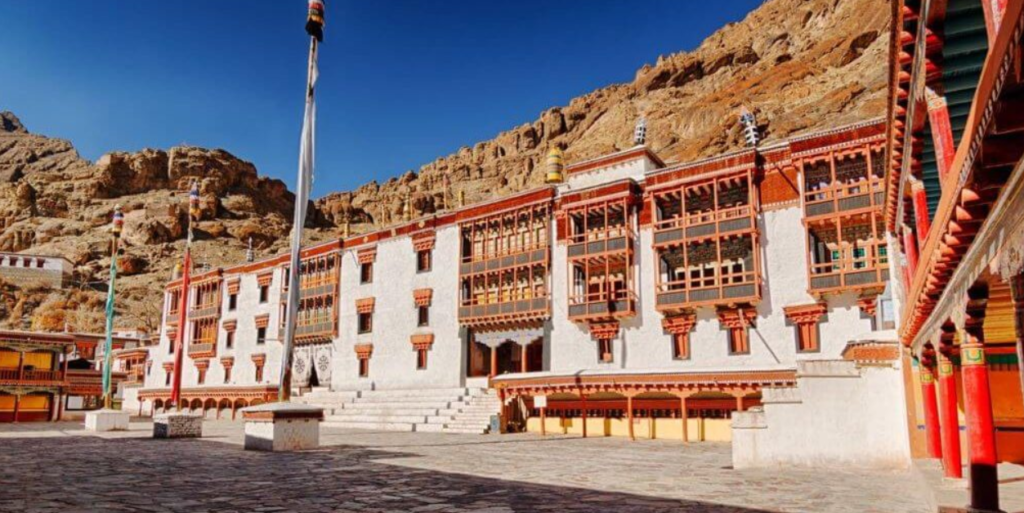
Ladakh’s largest and arguably most important monastery, Hemis is hidden inside a gorge in Hemis National Park, about an hour’s drive from Leh.
- Established: 17th century, with meditation caves possibly dating back to the 11th century.
- Highlights: Fascinating museum, spiritual ambiance, and rich Buddhist history.
Entry Fee: ₹100 (AU$2)
Alchi Monastery

Unlike other Ladakhi monasteries, Alchi is an ancient complex nestled in the Indus Valley, housing some of the world’s best-preserved Buddhist art and murals, nearly 1,000 years old.
- Location: Just off the Srinagar-Leh highway.
- Significance: Survived invasions due to its hidden location; considered a national treasure.
Entry Fee: ₹100 (AU$2)
Lamayuru Monastery

The oldest monastery in Ladakh, Lamayuru is a striking complex built into moon-like terrain along the Srinagar-Leh Highway.
- Founded: 11th century around a meditation cave used by Mahasiddha Naropa.
- Highlights: Towering mountain backdrop, ancient legends, and spiritual charm.
Travel Time from Leh: ~3 hours
Entry Fee: ₹50 (AU$1)
Trekking in Ladakh: Homestays, High Passes & Himalayan Adventures
Trekking in Ladakh offers a completely different experience from the more well-trodden trails of Nepal. The stark, high-altitude landscape around Leh is raw, remote, and largely untouched by mass tourism. It’s also one of the best ways to immerse yourself in Ladakhi culture and connect with life in rural mountain villages.
Homestay Treks
For those looking to trek independently without a guide, Ladakh offers two popular and accessible routes that use homestays for accommodation. These are ideal for trekkers seeking cultural immersion, scenic beauty, and minimal logistical hassle.
1. Sham Valley Trek (The “Baby Trek”)
- Duration: 2–4 days
- Max Elevation: ~3,900m
- Difficulty: Easy to Moderate
- Best For: Beginners or those short on time
Despite the nickname, the Sham Valley Trek offers much more than a “baby” adventure. This route winds through charming villages where you can stay with local families in traditional homestays. The trek doesn’t climb too much higher than Leh, making it ideal for those not fully acclimatised yet. Daily distances are manageable, and the scenery is spectacular throughout.
📍 Start/End: Likir to Temisgam or vice versa
2. Markha Valley Trek
- Duration: 4–6 days
- Max Elevation: 5,250m (Kongmaru La Pass)
- Difficulty: Moderate to Difficult
- Best For: Experienced trekkers seeking scenic variety and culture
This is one of Ladakh’s most iconic treks, traversing the beautiful Markha Valley just south of Leh. You’ll pass through ancient villages, cross high-altitude passes, and sleep in welcoming homestays each night. The views of Kang Yatse peak and the high desert landscape are unforgettable. Acclimatisation in Leh for at least 2–3 days is highly recommended before starting.
📍 Start: Chilling | End: Shang Sumdo (or reverse)
Camping Treks
For those wanting to go deeper into Ladakh’s wilderness—beyond the reach of villages and roads—a camping trek is the answer. These treks require a guide, mules for gear, and full logistics support. Local agencies in Leh can help organize these treks.
1. Parang La Trek (Kibber to Tso Moriri)
- Duration: 10 days
- Max Elevation: 5,580m (Parang La Pass)
- Difficulty: Very Difficult
- Best For: Experienced trekkers with high-altitude trekking experience
Following an ancient trade route between Spiti and Ladakh, this is one of the most spectacular and demanding treks in the Indian Himalayas. You’ll traverse vast, barren plateaus, glaciers, and high passes. Almost the entire route lies above 4,000m.
📍 Start: Kibber (Spiti) | End: Korzok (Tso Moriri)
2. Rumtse to Tso Moriri Trek
- Duration: 8 days
- Max Elevation: 5,400m
- Difficulty: Very Difficult
- Best For: Wilderness lovers seeking isolation and raw beauty
This high-altitude route runs through dramatic terrain, salt lakes like Tsokar, and nomadic settlements of the Changpa people. Expect to see wild kiangs (Tibetan wild asses), alpine meadows, and vast emptiness.
📍 Start: Rumtse | End: Korzok (Tso Moriri)
3. Zanskar Valley (Padum) to Darcha Trek
- Duration: 9–10 days
- Max Elevation: 5,091m (Shingo La Pass)
- Difficulty: Moderate to Difficult
- Best For: Trekkers seeking remote Himalayan culture before road access increases
Once a staple of Zanskar trekking, this route connects the secluded valley of Zanskar with Himachal’s Lahaul Valley. Road construction is changing the region fast, so this trek might not remain off-the-beaten-path for long. Now is the time to do it before the traffic builds.
📍 Start: Padum (Zanskar) | End: Darcha (Lahaul)
Trekking Tips for Ladakh:
- Acclimatisation: Spend at least 2–3 days in Leh before any trek above 4,000m.
- Permits: Inner Line Permits are needed for some routes—check with local agencies.
- Best Time to Trek: Late June to mid-September.
- Guides & Gear: Available for hire in Leh; most agencies can arrange full logistics for camping treks.
Trekking Agencies in Ladakh
For longer and more remote camping treks, it’s essential to hire a local trekking agency. Leh is filled with trekking operators—take the time to visit a few in person to compare costs, gear quality, and inclusions.
Why choosing the right agency matters:
On high-altitude treks, reliable gear, experienced guides, and solid logistics can make all the difference to your safety and enjoyment.
Essential Tips for Visiting Ladakh
💧 Water
The tap water in Ladakh is not safe to drink. To avoid buying plastic bottles (which often end up in landfills), carry a LifeStraw, Grayl, or another filtered water bottle.
📱 SIM Cards
Regular Indian SIMs usually don’t work in Ladakh or Kashmir. You’ll need to buy a local SIM in Leh.
👉 Airtel is the most reliable—find their shop down a small alley at the south end of Leh Market (marked as Airtel Store on Google Maps).
💵 Money & ATMs
There are a couple of SBI ATMs on the main market street in Leh. Expect queues, and they may occasionally run out of cash—but usually get refilled quickly.
🍷 Alcohol
Drinking is not a big part of the local culture, and you won’t see it served in most cafes or restaurants. However, a few wine and beer shops do exist—check their limited opening hours.
🗣️ Language
The primary language is Ladakhi, but you’ll also hear Tibetan, Hindi, and Kashmiri. English is commonly spoken in guesthouses, restaurants, and by tour guides—though taxi drivers may speak only basic English.
🎭 Festivals
Every monastery hosts its own masked dance festival, usually held in summer. Ask your guesthouse host about any upcoming events during your stay.
The Dalai Lama often visits Ladakh during summer and holds public teachings—an unforgettable experience if you’re lucky enough to catch it.
🌀 Cultural Etiquette
Always walk clockwise around stupas, mani walls, or prayer wheels as a sign of respect in Buddhist tradition—it is believed to purify negative karma.
Altitude Sickness in Ladakh
Leh sits at 3,500m, and nearly all treks or road trips in the region go higher. Altitude sickness is very common, especially for those flying directly from low elevations like Delhi.
⚠️ Common Symptoms
- Headache
- Nausea
- Shortness of breath
- Fatigue
🆘 Serious Symptoms
- Vomiting
- Dizziness or confusion
- Trouble walking or coordination
- Chest tightness or persistent cough
🏔️ Tips to Avoid Altitude Sickness
- Hydrate well: Start drinking more water even before you arrive.
- Rest for 2–3 days upon arrival in Leh. Limit walking to short, gentle strolls.
- Eat small, regular meals to keep energy up and reduce nausea.
- Consult a doctor about Diamox or other altitude meds—side effects vary.
- Do not ascend higher for at least 3–4 days after arriving. Avoid heading to places like Pangong Lake or going over Khardung La too soon.
Trip Budget: How Much Does Ladakh Cost?
If you’re travelling on a budget, here’s a breakdown of typical costs:
| Item | Cost (INR) | Approx. in USD/AUD |
|---|---|---|
| Dorm bed in a guesthouse | ₹450 | ~$5 / ~AU$9 |
| Private room in a guesthouse | ₹800 | ~$10 / ~AU$16 |
| Meal at a local eatery | ₹150 | ~$2 / ~AU$3 |
| Meal at a tourist-oriented restaurant | ₹350 | ~$4 / ~AU$6 |
| Monastery entry fee | ₹50 | <$1 |
| SIM card (Airtel, 28-day plan) | ₹500 | ~$6 / ~AU$10 |
| 3-day Pangong & Nubra tour (shared) | ₹4,000 | ~$48 / ~AU$80 |
| Inner Line Permit (3 days) | ₹560 | ~$7 / ~AU$11 |
FAQs for Traveling to Ladakh
1. What is the best time to visit Ladakh?
The ideal time to visit Ladakh is from June to September. During this period, the weather is pleasant, and most of the tourist attractions, including trekking routes, are accessible. The region experiences extreme cold from October to April, with heavy snowfall blocking many roads and passes.
2. Is it safe to travel to Ladakh?
Yes, Ladakh is generally safe for tourists. However, given its high-altitude location, travelers should be mindful of altitude sickness. It’s also important to check the security situation, especially near the borders with Tibet and Pakistan, before traveling.
3. What should I pack for Ladakh?
Pack warm clothes, even in summer, as temperatures can drop significantly, especially at night. Don’t forget a hat, gloves, sunscreen, and sunglasses to protect yourself from the intense UV rays. If you plan to trek, comfortable trekking shoes and a waterproof jacket are essential.
4. How do I prepare for altitude sickness?
To minimize the risk of altitude sickness:
- Spend the first 2-3 days in Leh acclimatizing.
- Hydrate well and eat light, regular meals.
- Avoid strenuous activities during the first few days.
- Consider taking Diamox (after consulting a doctor) to help with acclimatization.
5. Can I travel to Ladakh without a permit?
Most of Ladakh doesn’t require a permit, but for certain regions near sensitive borders (like Pangong Lake, Nubra Valley, and Zanskar), you’ll need an Inner Line Permit (ILP). It’s typically easy to get one in Leh.
6. Is it necessary to hire a guide for trekking?
For shorter, easier treks like the Sham Valley Trek, you can go independently and use homestays for accommodation. However, for longer or more challenging treks, it’s highly recommended to hire a local trekking guide to ensure safety, proper navigation, and knowledge of the terrain.
7. How do I get to Ladakh?
The most common way to reach Ladakh is by flight to Leh’s Kushok Bakula Rimpochee Airport, which is well-connected with cities like Delhi, Srinagar, and Mumbai. Alternatively, you can travel by road through Manali-Leh Highway or Srinagar-Leh Highway, both of which offer stunning views but are only open in summer months.
8. What is the best way to move around Ladakh?
- Local taxis are commonly used to move around Leh and nearby attractions.
- If traveling to remote areas like Pangong Lake or Nubra Valley, you can book private or shared jeeps.
- Bicycles and motorbikes are also popular options for adventurous travelers who want flexibility and scenic routes.
9. Can I use my regular Indian SIM card in Ladakh?
No, regular Indian SIM cards (except Airtel or BSNL) generally won’t work in Ladakh. You will need to buy a local SIM card in Leh upon arrival for communication.
10. What is the food like in Ladakh?
Ladakhi cuisine is influenced by Tibetan and Central Asian cultures. You’ll find hearty thukpa (noodle soup), momos (dumplings), and tsampa (roasted barley flour). Butter tea (chailo) is popular, especially for cold weather. Restaurants in Leh cater to international tastes, but in remote areas, meals are mostly traditional.
11. Can I get cash in Ladakh?
While there are a few ATMs in Leh, they may run out of cash occasionally. It’s advisable to carry enough cash for your trip, especially if you’re traveling to remote areas where ATMs may not be available.
12. Are there any festivals in Ladakh?
Yes, Ladakh has many cultural and religious festivals. Each monastery has its own festival, which usually includes masked dances by monks. Some of the major festivals are:
- Hemis Festival (June-July)
- Losar (Ladakhi New Year, February)
- Thiksey Festival (October)
These festivals are colorful and vibrant, providing great opportunities to experience the local culture.
13. Is Ladakh suitable for family travel?
Yes, Ladakh is suitable for families, particularly those who enjoy scenic landscapes and nature. However, children and elderly people should be cautious of altitude sickness. Choose shorter treks or relax at guesthouses for a more laid-back experience.
14. Can I drink tap water in Ladakh?
No, tap water is not safe to drink. It’s best to use a water filter bottle or buy bottled water from local shops. Many accommodations provide boiled water, so you can refill your bottle for free or for a small charge.
